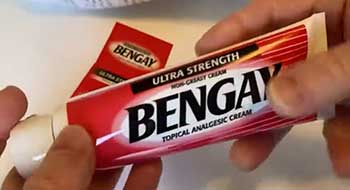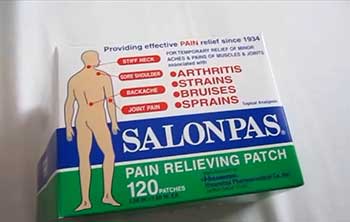If you’re someone who deals with muscle aches, joint pain, arthritis, or backaches, you’ve probably heard of Bengay and Salonpas. These are two of the most popular topical pain relievers on the market. But what’s the difference between them and which one is better?
This comprehensive guide will compare Bengay and Salonpas on ingredients, effectiveness, uses, side effects, and more to help you decide which topical analgesic is right for your pain relief needs.
A Brief Comparison Table
| Aspects | Bengay | Salonpas |
| Active Ingredients | Menthol, camphor, methyl salicylate | Menthol, methyl salicylate, capsaicin |
| Pain Relief Strength | Mild to moderate | Strong, intense |
| Sensation | Cooling | Heating |
| Odor | Strong medicinal camphor smell | Milder odor |
| Common Uses | Arthritis, muscle soreness, mild back pain | Chronic back pain, sciatica, osteoarthritis, sports injuries |
| Cost | $6-$15 for creams/gels, $10-$15 for 10 patches | $11-$16 for creams/gels, $11-$16 for 10-12 patches |
| Side Effects | Skin irritation, increased pain/burning, headache | Skin irritation, increased pain/burning, headache |
Overview Of Bengay And Salonpas
Bengay and Salonpas are both topical analgesics that can be rubbed on the skin to relieve muscle, joint, and arthritis pain. They work by reducing inflammation and stimulating blood flow. This provides a cooling, soothing sensation along with pain relief.
Both Bengay and Salonpas are available as creams, gels, patches, and sprays. They can be purchased over-the-counter in pharmacies, grocery stores, and online. Generic versions are also available under different brand names.

While they share some similarities, there are some key differences between Bengay and Salonpas:
- Active ingredients – Bengay contains menthol, camphor, and methyl salicylate. Salonpas contains menthol, methyl salicylate, and capsaicin.
- Strength – Salonpas tends to provide stronger, more intense pain relief compared to Bengay.
- Odor – Bengay has a stronger medicinal odor than Salonpas creams due to higher camphor content.
- Sensation – Salonpas creates a heating sensation on the skin, while Bengay provides more of a cooling sensation.
- Uses – While both can treat general aches and pains, Bengay is marketed more for arthritis pain and Salonpas is marketed more for backaches.
Now let’s look at the key ingredients in both topical analgesics.
Active Ingredients In Bengay And Salonpas
The main active ingredients in Bengay and Salonpas responsible for pain relief include:
Menthol
Menthol provides a cooling, refreshing sensation by stimulating cold receptors on the skin. It helps reduce pain perception from irritable nerve endings. Menthol is a higher concentration in Bengay (10-15%) compared to Salonpas creams (3-5%).
Camphor
Camphor produces a gentle warming and numbing effect on the skin. It helps relieve muscle spasms and inflammation when applied topically. Camphor is found in Bengay (3-11%) but not in Salonpas.
Methyl Salicylate
Known as wintergreen oil, methyl salicylate helps relieve muscle and joint aches. It works by countering inflammation that causes pain. Methyl salicylate concentration is typically 10-15% in both Bengay and Salonpas.
Capsaicin
Found only in Salonpas, capsaicin helps alleviate pain by reducing substance P, a neurotransmitter that sends pain signals to the brain. It creates a heating effect when applied to the skin. Salonpas contains 0.025-0.075% capsaicin.
Also Read: Is Penetrex Better Than Voltaren?
Which Provides Better Pain Relief: Bengay Or Salonpas?
Many people find Salonpas provides more intense, longer lasting pain relief compared to Bengay. Here’s why that may be the case:

- Salonpas contains capsaicin, which Bengay does not. Capsaicin helps “overwrite” pain signals, providing significant pain reduction.
- With 10-15% menthol, Bengay can sometimes provide too much of a cooling sensation that counteracts the numbing benefits, compared to Salonpas’ 3-5% menthol.
- Salonpas typically contains higher levels of methyl salicylate (15-30%) compared to 10-15% in Bengay.
- Multiple clinical studies have shown Salonpas patches consistently provide superior pain relief compared to Bengay, placebo, and no treatment. [1]
However, some people may prefer Bengay’s odor, gentler sensation, and ease of availability. Overall Salonpas appears more effective for severe, acute, or chronic pain, while Bengay may suit milder aches and pains.
Common Uses For Bengay And Salonpas
Both Bengay and Salonpas can treat a variety of muscle, joint, back, and arthritis pains including:
- Sore, overworked muscles from exercise or sports
- Stiff, painful joints from arthritis
- Lower back pain and backaches
- Neck and shoulder pain
- Knee, elbow, wrist, and ankle pain
- Muscle sprains and strains
- Bruises and sprains
- Foot pain
However, Bengay and Salonpas tend to be marketed more for these specific uses:
Bengay
- Arthritis pain
- Back pain
- Muscle soreness
- Joint pain
- Sprains and strains
Salonpas
- Severe muscle pain
- Chronic back pain
- Sciatica
- Rheumatoid arthritis
- Osteoarthritis
- Sports injuries
So while you can use either for general aches and pains, Bengay may be better for mild joint pain and Salonpas may work better for intense or chronic back and arthritis pain.
Also Read: Differences Between Amazon Allergy And Zyrtec.
How To Use Bengay And Salonpas
Bengay and Salonpas are easy to apply topically as a cream, gel, spray, or patch:
Creams/Gels: Apply a thin layer to affected area 1-4 times daily. Rub in fully. Wash hands after application.
Sprays: Spray directly on sore areas or spray into hands and massage into skin 1-4 times a day.
Patches: Apply patch to most painful spot up to 2 times daily. Patches provide up to 12 hours of pain relief. Cut patches to size if needed.
Avoid using Bengay or Salonpas on wounds, damaged skin, or before heat therapy. Always read label directions before using.
Side Effects And Precautions
When used occasionally, topical pain relievers like Bengay and Salonpas are generally safe with minimal risks. However, they can cause side effects including:
- Skin irritation, rashes, itching, redness, and swelling
- Warm/hot sensation or cooling sensation
- Increased pain or burning
- Allergic reactions (uncommon)
- Headaches, dizziness, nausea when overapplied
To reduce risk of side effects:
- Use sparingly and don’t overapply products
- Avoid contact with eyes, nose, and mouth
- Don’t apply to wounds or damaged skin
- Don’t use before heat therapy like hot baths or showers
- Discontinue use if irritation develops
Those with health conditions like high blood pressure, diabetes, heart disease, Raynaud’s disease should consult a doctor before using.
Cost Comparison Of Bengay Vs. Salonpas
Both Bengay and Salonpas are affordable options for pain relief available without a prescription. On average:
- Bengay cream: $6-$12 for 1.5 – 3 oz tube
- Salonpas cream: $11-$15 for 1.76 – 3.3 oz tube
- Bengay patch: $10-$15 for 10 patches
- Salonpas patch: $11-$16 for 10-12 patches
So the cost tends to be comparable. Salonpas patches may be slightly more expensive than Bengay patches. Generic versions usually cost a bit less than big brand names.
Also watch the review video of Bengay!
Frequently Asked Questions (FAQ)
Salonpas and Bengay share some active ingredients like menthol and methyl salicylate, but Salonpas contains capsaicin while Bengay contains camphor instead. This gives them a similar effect with some different properties. Salonpas tends to provide stronger, heating pain relief compared to Bengay’s cooling sensation.
Many people find Salonpas provides superior pain relief compared to Bengay, likely due to its capsaicin content. Studies show Salonpas patches consistently outperform Bengay. Other topical pain relievers like Voltaren gel, Aspercreme, and Flexall are also comparable or potentially better options than Bengay for certain ailments.
Clinical studies have found Salonpas patches to provide the most potent pain relief compared to Bengay, Aspercreme, and capsaicin patches alone. Salonpas patches effectively treat chronic or acute muscle and back pain for up to 12 hours.
The “best” pain relief cream depends on the type of pain. For arthritis, Voltaren gel works well by reducing inflammation. For backaches, Salonpas and capsaicin creams penetrate deep to relieve sore muscles and joints. For nerve pain, lidocaine creams may provide the most complete relief by numbing irritated nerves.
Also Read: Choose Between Aveeno Eczema Balm And Cream.
The Bottom Line
Salonpas and Bengay both provide cooling, soothing relief for muscle aches, back pain, arthritis, strains, sprains, and bruises. Both are affordable, accessible options to treat general pain issues. However, Salonpas tends to provide longer lasting, more intense pain relief, especially for chronic pain.
This may be due to Salonpas containing capsaicin and higher levels of menthol and methyl salicylate than Bengay. Studies consistently show Salonpas patches outperform Bengay.
If you want gentle, cooling relief for mild soreness, Bengay may be a good option to try first. But for intense, chronic pains from arthritis, sciatica or backaches, Salonpas is likely the stronger choice. Those with chronic conditions should consult their doctor before using any new medications.
By understanding the key ingredient differences and performance comparisons, you can decide whether Bengay or Salonpas topical analgesic best suits your specific pain relief needs. Both provide accessible options to help soothe muscle aches and joint pains when applied topically.
